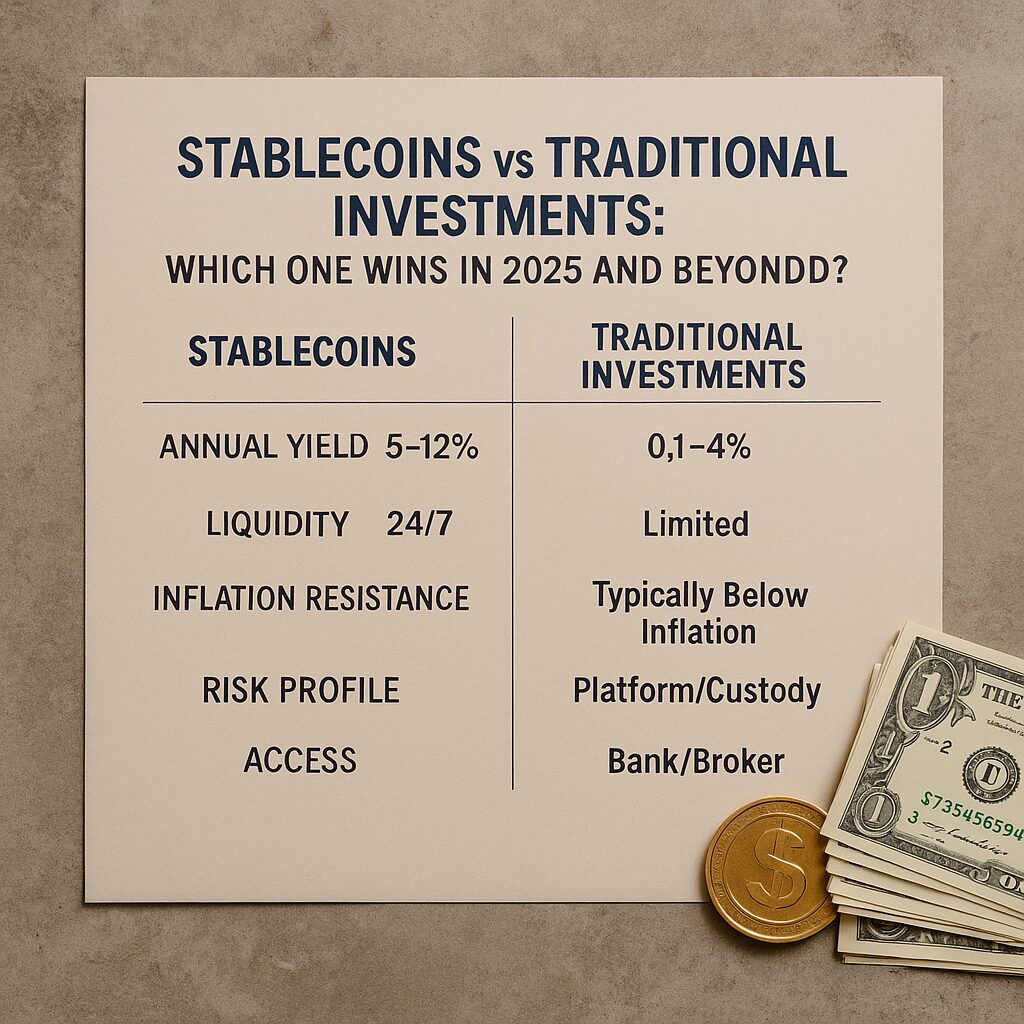In an era of rising inflation, market volatility, and shrinking bank yields, investors around the world are asking one critical question:
Are stablecoins a better alternative to traditional financial instruments?
This guide offers a deep, side-by-side comparison between stablecoins and legacy investments like bonds, savings accounts, and CDs. We’ll explore risk, return, accessibility, liquidity, and long-term growth potential—so you can decide where your money belongs.
The New Face of Money: What Are Stablecoins?
Stablecoins are digital currencies pegged to the value of real-world assets—typically the U.S. dollar. Unlike Bitcoin or Ethereum, their value remains stable, making them attractive for savings and income generation.
Popular examples include:
- USDC – Backed by fully reserved assets, regularly audited
- USDT – The most traded stablecoin, widely used in crypto exchanges
- DAI – Decentralized, backed by smart contracts and overcollateralization
- FRAX, TUSD, LUSD – Emerging alternatives with specific advantages
How Do Traditional Investments Work?
For decades, people relied on traditional investments to grow their wealth securely:
- Savings Accounts: Low interest, high liquidity, insured by central banks
- Certificates of Deposit (CDs): Fixed-term deposits with higher yields
- Government Bonds: Low-risk instruments, often used in retirement plans
- Corporate Bonds & Mutual Funds: Moderate to high returns with varying risk
But in many countries, these instruments now deliver less than inflation, resulting in negative real returns.
Head-to-Head Comparison: Stablecoins vs Traditional Tools
| Feature | Stablecoins | Traditional Investments |
|---|---|---|
| Annual Yield | 5–12% (platform dependent) | 0.1–4% (avg. global range) |
| Liquidity | 24/7, instant redemption | Limited, tied to bank hours |
| Inflation Resistance | Often pegged to USD | Typically below inflation |
| Risk Profile | Platform/custody risks | Market and interest rate risks |
| Access | Global, borderless, no credit check | Bank accounts or brokerages needed |
| Volatility | Low (by design) | Low to moderate (bond value fluctuations) |
| Insurance | Platform-specific insurance | Government-backed (FDIC, etc.) |
The Real Cost of Playing It Safe
Many conservative savers park their cash in traditional tools thinking they’re “safe.” But safety isn’t just about avoiding risk—it’s also about preserving purchasing power.
Example:
If inflation is 5% and your savings account pays 1%, you’re losing 4% of your money every year in real terms.
In contrast, even a 6% yield from a regulated stablecoin platform puts you ahead of inflation, growing your wealth instead of eroding it.
Use Case Scenarios
1. The Conservative Saver
- Wants predictable returns
- Doesn’t want crypto volatility
- Recommended: Stablecoin savings on CeFi platforms like Nexo or Crypto.com with daily interest payouts
2. The Risk-Averse Investor
- Currently holds government bonds
- Accepts minimal return
- Recommended: Short-term stablecoin strategies with withdrawal flexibility
3. The Tech-Savvy Explorer
- Comfortable using DeFi platforms
- Seeks optimized yields
- Recommended: Aave, Compound, Curve—diversified for safety and performance
What About Taxes and Regulation?
- Stablecoins: Interest may be taxable in your country. Always document deposits, earnings, and withdrawals.
- Traditional Investments: Usually well-defined tax structures, but may have hidden fees or early withdrawal penalties.
Legal Tip: Stick with platforms that provide transaction reports and are registered or licensed in your jurisdiction.
The Verdict: Which One Wins?
| Profile | Best Option |
|---|---|
| Low risk, global access | Stablecoins (via CeFi) |
| Retirement planning | Government Bonds/CDs |
| Wealth growth | Diversified stablecoin strategies |
| Inflation hedge | Stablecoins with 5%+ yield |
| Regulatory clarity | Traditional bank products (for now) |
There’s no “one-size-fits-all” solution—but in a world where inflation erodes fiat faster than ever, stablecoins offer a modern, flexible, and potentially more profitable alternative.
Pro Tips for Stablecoin Users
- Start small: Test platforms with low amounts before scaling.
- Diversify: Use both CeFi and DeFi to balance yield and risk.
- Monitor APY and fees: Rates can change rapidly.
- Stay compliant: Check your country’s rules for digital asset income.
